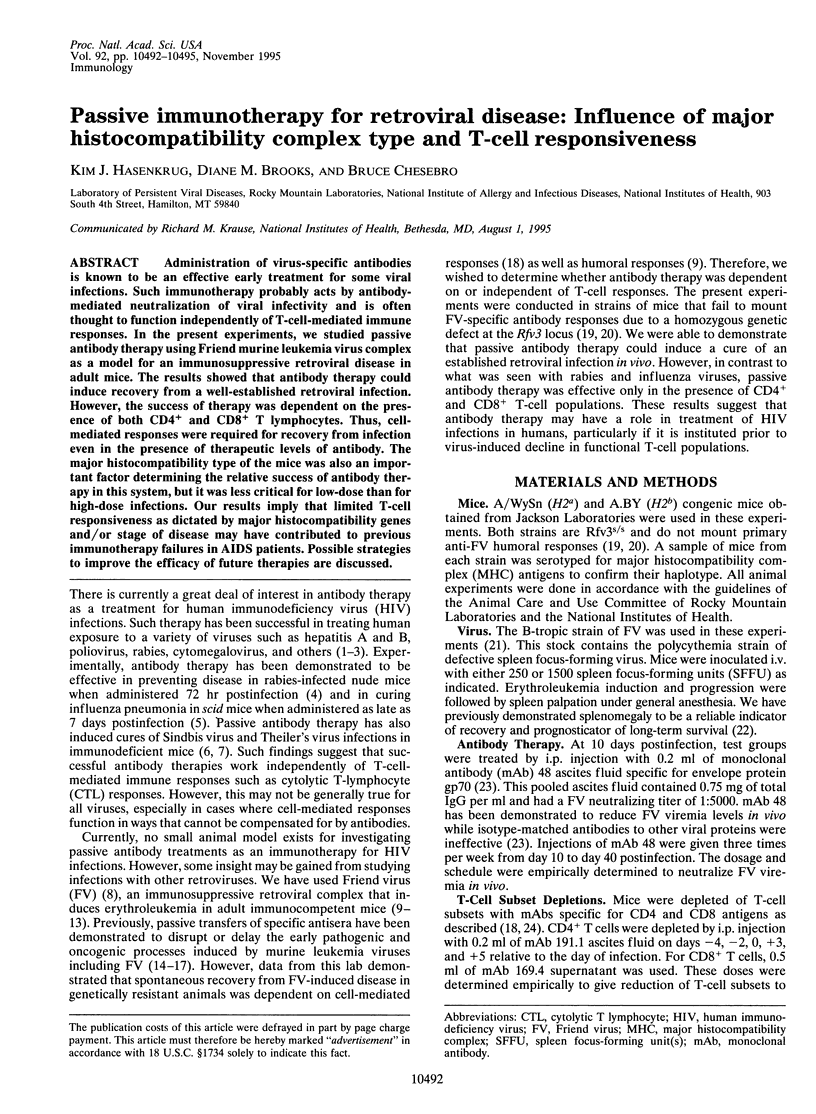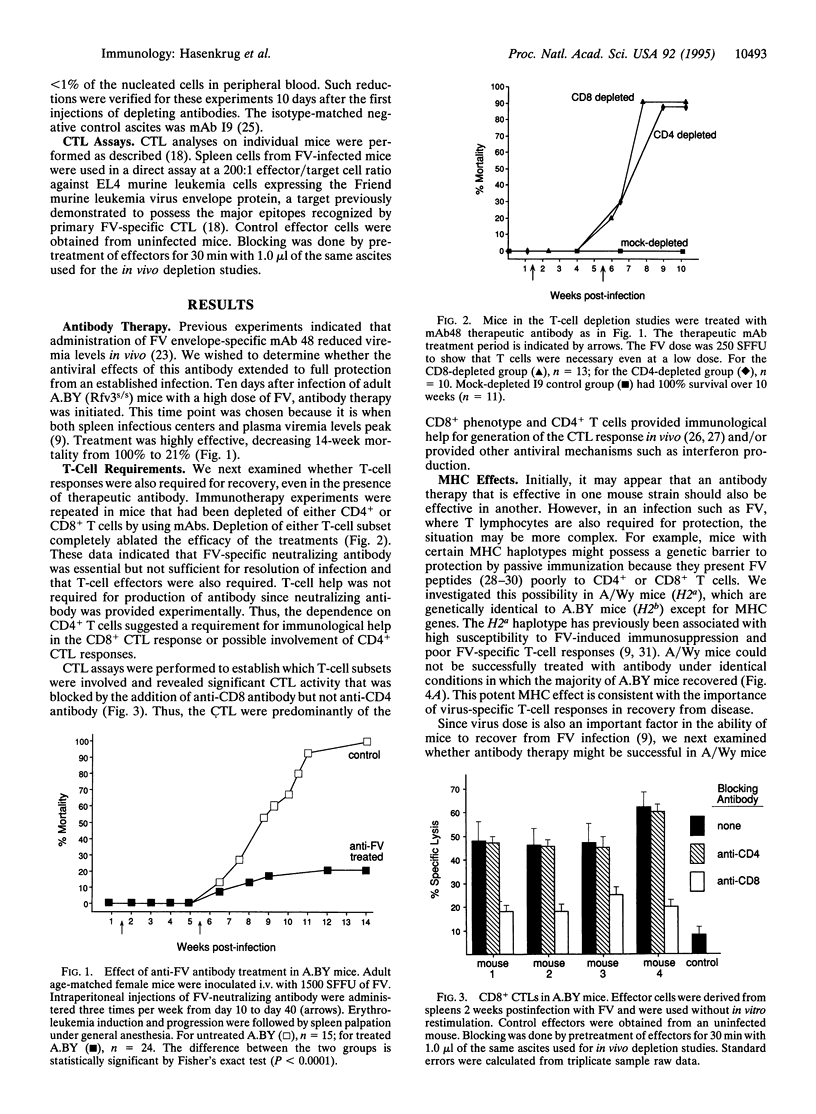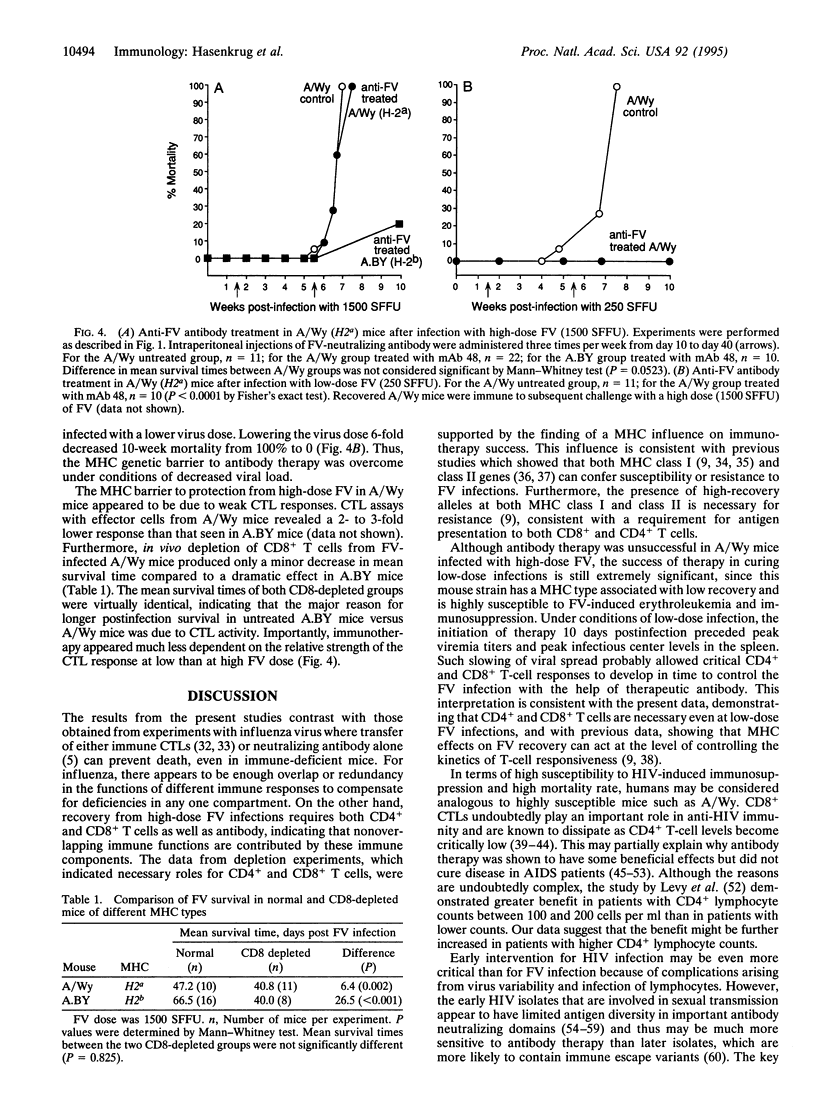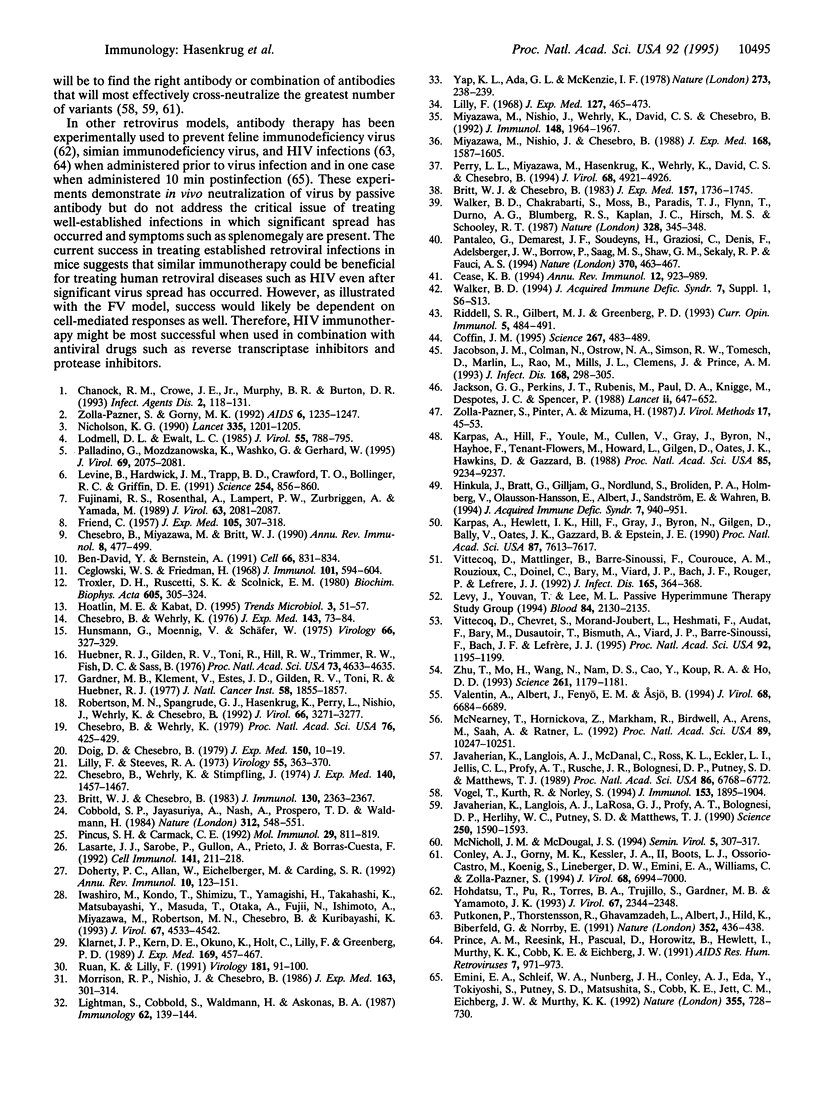Abstract
Administration of virus-specific antibodies is known to be an effective early treatment for some viral infections. Such immunotherapy probably acts by antibody-mediated neutralization of viral infectivity and is often thought to function independently of T-cell-mediated immune responses. In the present experiments, we studied passive antibody therapy using Friend murine leukemia virus complex as a model for an immunosuppressive retroviral disease in adult mice. The results showed that antibody therapy could induce recovery from a well-established retroviral infection. However, the success of therapy was dependent on the presence of both CD4+ and CD8+ T lymphocytes. Thus, cell-mediated responses were required for recovery from infection even in the presence of therapeutic levels of antibody. The major histocompatibility type of the mice was also an important factor determining the relative success of antibody therapy in this system, but it was less critical for low-dose than for high-dose infections. Our results imply that limited T-cell responsiveness as dictated by major histocompatibility genes and/or stage of disease may have contributed to previous immunotherapy failures in AIDS patients. Possible strategies to improve the efficacy of future therapies are discussed.
Full text
PDF



Selected References
These references are in PubMed. This may not be the complete list of references from this article.
- Ben-David Y., Bernstein A. Friend virus-induced erythroleukemia and the multistage nature of cancer. Cell. 1991 Sep 6;66(5):831–834. doi: 10.1016/0092-8674(91)90428-2. [DOI] [PubMed] [Google Scholar]
- Britt W. J., Chesebro B. H-2D control of recovery from Friend virus leukemia: H-2D region influences the kinetics of the T lymphocyte response to Friend virus. J Exp Med. 1983 Jun 1;157(6):1736–1745. doi: 10.1084/jem.157.6.1736. [DOI] [PMC free article] [PubMed] [Google Scholar]
- Britt W. J., Chesebro B. Use of monoclonal anti-gp70 antibodies to mimic the effects of the Rfv-3 gene in mice with Friend virus-induced leukemia. J Immunol. 1983 May;130(5):2363–2367. [PubMed] [Google Scholar]
- Cease K. B., Berzofsky J. A. Toward a vaccine for AIDS: the emergence of immunobiology-based vaccine development. Annu Rev Immunol. 1994;12:923–989. doi: 10.1146/annurev.iy.12.040194.004423. [DOI] [PubMed] [Google Scholar]
- Ceglowski W. S., Friedman H. Immunosuppression by leukemia viruses. I. Effect of Friend disease virus on cellular and humoral hemolysin responses of mice to a primary immunization with sheep erythrocytes. J Immunol. 1968 Sep;101(3):594–604. [PubMed] [Google Scholar]
- Chanock R. M., Crowe J. E., Jr, Murphy B. R., Burton D. R. Human monoclonal antibody Fab fragments cloned from combinatorial libraries: potential usefulness in prevention and/or treatment of major human viral diseases. Infect Agents Dis. 1993 Jun;2(3):118–131. [PubMed] [Google Scholar]
- Chesebro B., Miyazawa M., Britt W. J. Host genetic control of spontaneous and induced immunity to Friend murine retrovirus infection. Annu Rev Immunol. 1990;8:477–499. doi: 10.1146/annurev.iy.08.040190.002401. [DOI] [PubMed] [Google Scholar]
- Chesebro B., Wehrly K. Identification of a non-H-2 gene (Rfv-3) influencing recovery from viremia and leukemia induced by Friend virus complex. Proc Natl Acad Sci U S A. 1979 Jan;76(1):425–429. doi: 10.1073/pnas.76.1.425. [DOI] [PMC free article] [PubMed] [Google Scholar]
- Chesebro B., Wehrly K., Stimpfling J. Host genetic control of recovery from Friend leukemia virus-induced splenomegaly: mapping of a gene within the major histocompatability complex. J Exp Med. 1974 Dec 1;140(6):1457–1467. doi: 10.1084/jem.140.6.1457. [DOI] [PMC free article] [PubMed] [Google Scholar]
- Chesebro B., Wehrly K. Studies on the role of the host immune response in recovery from Friend virus leukemia. I. Antiviral and antileukemia cell antibodies. J Exp Med. 1976 Jan 1;143(1):73–84. doi: 10.1084/jem.143.1.73. [DOI] [PMC free article] [PubMed] [Google Scholar]
- Cobbold S. P., Jayasuriya A., Nash A., Prospero T. D., Waldmann H. Therapy with monoclonal antibodies by elimination of T-cell subsets in vivo. Nature. 1984 Dec 6;312(5994):548–551. doi: 10.1038/312548a0. [DOI] [PubMed] [Google Scholar]
- Coffin J. M. HIV population dynamics in vivo: implications for genetic variation, pathogenesis, and therapy. Science. 1995 Jan 27;267(5197):483–489. doi: 10.1126/science.7824947. [DOI] [PubMed] [Google Scholar]
- Conley A. J., Gorny M. K., Kessler J. A., 2nd, Boots L. J., Ossorio-Castro M., Koenig S., Lineberger D. W., Emini E. A., Williams C., Zolla-Pazner S. Neutralization of primary human immunodeficiency virus type 1 isolates by the broadly reactive anti-V3 monoclonal antibody, 447-52D. J Virol. 1994 Nov;68(11):6994–7000. doi: 10.1128/jvi.68.11.6994-7000.1994. [DOI] [PMC free article] [PubMed] [Google Scholar]
- Doherty P. C., Allan W., Eichelberger M., Carding S. R. Roles of alpha beta and gamma delta T cell subsets in viral immunity. Annu Rev Immunol. 1992;10:123–151. doi: 10.1146/annurev.iy.10.040192.001011. [DOI] [PubMed] [Google Scholar]
- Doig D., Chesebro B. Anti-Friend virus antibody is associated with recovery from viremia and loss of viral leukemia cell-surface antigens in leukemic mice. Identification of Rfv-3 as a gene locus influencing antibody production. J Exp Med. 1979 Jul 1;150(1):10–19. doi: 10.1084/jem.150.1.10. [DOI] [PMC free article] [PubMed] [Google Scholar]
- Emini E. A., Schleif W. A., Nunberg J. H., Conley A. J., Eda Y., Tokiyoshi S., Putney S. D., Matsushita S., Cobb K. E., Jett C. M. Prevention of HIV-1 infection in chimpanzees by gp120 V3 domain-specific monoclonal antibody. Nature. 1992 Feb 20;355(6362):728–730. doi: 10.1038/355728a0. [DOI] [PubMed] [Google Scholar]
- FRIEND C. Cell-free transmission in adult Swiss mice of a disease having the character of a leukemia. J Exp Med. 1957 Apr 1;105(4):307–318. doi: 10.1084/jem.105.4.307. [DOI] [PMC free article] [PubMed] [Google Scholar]
- Fujinami R. S., Rosenthal A., Lampert P. W., Zurbriggen A., Yamada M. Survival of athymic (nu/nu) mice after Theiler's murine encephalomyelitis virus infection by passive administration of neutralizing monoclonal antibody. J Virol. 1989 May;63(5):2081–2087. doi: 10.1128/jvi.63.5.2081-2087.1989. [DOI] [PMC free article] [PubMed] [Google Scholar]
- Gardner M. B., Klement V., Estes J. D., Gilden R. V., Toni R., Huebner R. J. Suppression of infectious murine leukemia virus in wild mice (Mus musculus) by passive immunization. J Natl Cancer Inst. 1977 Jun;58(6):1855–1857. doi: 10.1093/jnci/58.6.1855. [DOI] [PubMed] [Google Scholar]
- Hinkula J., Bratt G., Gilljam G., Nordlund S., Broliden P. A., Holmberg V., Olausson-Hansson E., Albert J., Sandström E., Wahren B. Immunological and virological interactions in patients receiving passive immunotherapy with HIV-1 neutralizing monoclonal antibodies. J Acquir Immune Defic Syndr. 1994 Sep;7(9):940–951. [PubMed] [Google Scholar]
- Hoatlin M. E., Kabat D. Host-range control of a retroviral disease: Friend erythroleukemia. Trends Microbiol. 1995 Feb;3(2):51–57. doi: 10.1016/s0966-842x(00)88875-7. [DOI] [PubMed] [Google Scholar]
- Hohdatsu T., Pu R., Torres B. A., Trujillo S., Gardner M. B., Yamamoto J. K. Passive antibody protection of cats against feline immunodeficiency virus infection. J Virol. 1993 Apr;67(4):2344–2348. doi: 10.1128/jvi.67.4.2344-2348.1993. [DOI] [PMC free article] [PubMed] [Google Scholar]
- Huebner R. J., Gilden R. V., Toni R., Hill R. W., Trimmer R. W., Fish D. C., Sass B. Prevention of spontaneous leukemia in AKR mice by type-specific immunosuppression of endogenous ecotropic virogenes. Proc Natl Acad Sci U S A. 1976 Dec;73(12):4633–4635. doi: 10.1073/pnas.73.12.4633. [DOI] [PMC free article] [PubMed] [Google Scholar]
- Hunsmann G., Moennig V., Schäfer W. Properties of mouse leukemia viruses. IX. Active and passive immunization of mice against Friend leukemia with isolated viral GP71 glycoprotein and its corresponding antiserum. Virology. 1975 Jul;66(1):327–329. doi: 10.1016/0042-6822(75)90203-2. [DOI] [PubMed] [Google Scholar]
- Iwashiro M., Kondo T., Shimizu T., Yamagishi H., Takahashi K., Matsubayashi Y., Masuda T., Otaka A., Fujii N., Ishimoto A. Multiplicity of virus-encoded helper T-cell epitopes expressed on FBL-3 tumor cells. J Virol. 1993 Aug;67(8):4533–4542. doi: 10.1128/jvi.67.8.4533-4542.1993. [DOI] [PMC free article] [PubMed] [Google Scholar]
- Jackson G. G., Perkins J. T., Rubenis M., Paul D. A., Knigge M., Despotes J. C., Spencer P. Passive immunoneutralization of human immunodeficiency virus in patients with advanced AIDS. Lancet. 1988 Sep 17;2(8612):647–652. doi: 10.1016/s0140-6736(88)90468-0. [DOI] [PubMed] [Google Scholar]
- Jacobson J. M., Colman N., Ostrow N. A., Simson R. W., Tomesch D., Marlin L., Rao M., Mills J. L., Clemens J., Prince A. M. Passive immunotherapy in the treatment of advanced human immunodeficiency virus infection. J Infect Dis. 1993 Aug;168(2):298–305. doi: 10.1093/infdis/168.2.298. [DOI] [PubMed] [Google Scholar]
- Javaherian K., Langlois A. J., LaRosa G. J., Profy A. T., Bolognesi D. P., Herlihy W. C., Putney S. D., Matthews T. J. Broadly neutralizing antibodies elicited by the hypervariable neutralizing determinant of HIV-1. Science. 1990 Dec 14;250(4987):1590–1593. doi: 10.1126/science.1703322. [DOI] [PubMed] [Google Scholar]
- Javaherian K., Langlois A. J., McDanal C., Ross K. L., Eckler L. I., Jellis C. L., Profy A. T., Rusche J. R., Bolognesi D. P., Putney S. D. Principal neutralizing domain of the human immunodeficiency virus type 1 envelope protein. Proc Natl Acad Sci U S A. 1989 Sep;86(17):6768–6772. doi: 10.1073/pnas.86.17.6768. [DOI] [PMC free article] [PubMed] [Google Scholar]
- Karpas A., Hewlett I. K., Hill F., Gray J., Byron N., Gilgen D., Bally V., Oates J. K., Gazzard B., Epstein J. E. Polymerase chain reaction evidence for human immunodeficiency virus 1 neutralization by passive immunization in patients with AIDS and AIDS-related complex. Proc Natl Acad Sci U S A. 1990 Oct;87(19):7613–7617. doi: 10.1073/pnas.87.19.7613. [DOI] [PMC free article] [PubMed] [Google Scholar]
- Karpas A., Hill F., Youle M., Cullen V., Gray J., Byron N., Hayhoe F., Tenant-Flowers M., Howard L., Gilgen D. Effects of passive immunization in patients with the acquired immunodeficiency syndrome-related complex and acquired immunodeficiency syndrome. Proc Natl Acad Sci U S A. 1988 Dec;85(23):9234–9237. doi: 10.1073/pnas.85.23.9234. [DOI] [PMC free article] [PubMed] [Google Scholar]
- Klarnet J. P., Kern D. E., Okuno K., Holt C., Lilly F., Greenberg P. D. FBL-reactive CD8+ cytotoxic and CD4+ helper T lymphocytes recognize distinct Friend murine leukemia virus-encoded antigens. J Exp Med. 1989 Feb 1;169(2):457–467. doi: 10.1084/jem.169.2.457. [DOI] [PMC free article] [PubMed] [Google Scholar]
- Lasarte J. J., Sarobe P., Gullón A., Prieto J., Borrás-Cuesta F. Induction of cytotoxic T lymphocytes in mice against the principal neutralizing domain of HIV-1 by immunization with an engineered T-cytotoxic-T-helper synthetic peptide construct. Cell Immunol. 1992 Apr 15;141(1):211–218. doi: 10.1016/0008-8749(92)90140-k. [DOI] [PubMed] [Google Scholar]
- Levine B., Hardwick J. M., Trapp B. D., Crawford T. O., Bollinger R. C., Griffin D. E. Antibody-mediated clearance of alphavirus infection from neurons. Science. 1991 Nov 8;254(5033):856–860. doi: 10.1126/science.1658936. [DOI] [PubMed] [Google Scholar]
- Levy J., Youvan T., Lee M. L. Passive hyperimmune plasma therapy in the treatment of acquired immunodeficiency syndrome: results of a 12-month multicenter double-blind controlled trial. The Passive Hyperimmune Therapy Study Group. Blood. 1994 Oct 1;84(7):2130–2135. [PubMed] [Google Scholar]
- Lightman S., Cobbold S., Waldmann H., Askonas B. A. Do L3T4+ T cells act as effector cells in protection against influenza virus infection. Immunology. 1987 Sep;62(1):139–144. [PMC free article] [PubMed] [Google Scholar]
- Lilly F., Steeves R. A. B-tropic Friend virus: a host-range pseudotype of spleen focus-forming virus (SFFV). Virology. 1973 Oct;55(2):363–370. doi: 10.1016/0042-6822(73)90176-1. [DOI] [PubMed] [Google Scholar]
- Lilly F. The effect of histocompatibility-2 type on response to friend leukemia virus in mice. J Exp Med. 1968 Mar 1;127(3):465–473. doi: 10.1084/jem.127.3.465. [DOI] [PMC free article] [PubMed] [Google Scholar]
- Lodmell D. L., Ewalt L. C. Pathogenesis of street rabies virus infections in resistant and susceptible strains of mice. J Virol. 1985 Sep;55(3):788–795. doi: 10.1128/jvi.55.3.788-795.1985. [DOI] [PMC free article] [PubMed] [Google Scholar]
- McNearney T., Hornickova Z., Markham R., Birdwell A., Arens M., Saah A., Ratner L. Relationship of human immunodeficiency virus type 1 sequence heterogeneity to stage of disease. Proc Natl Acad Sci U S A. 1992 Nov 1;89(21):10247–10251. doi: 10.1073/pnas.89.21.10247. [DOI] [PMC free article] [PubMed] [Google Scholar]
- Miyazawa M., Nishio J., Chesebro B. Genetic control of T cell responsiveness to the Friend murine leukemia virus envelope antigen. Identification of class II loci of the H-2 as immune response genes. J Exp Med. 1988 Nov 1;168(5):1587–1605. doi: 10.1084/jem.168.5.1587. [DOI] [PMC free article] [PubMed] [Google Scholar]
- Miyazawa M., Nishio J., Wehrly K., David C. S., Chesebro B. Spontaneous recovery from Friend retrovirus-induced leukemia. Mapping of the Rfv-2 gene in the Q/TL region of mouse MHC. J Immunol. 1992 Mar 15;148(6):1964–1967. [PubMed] [Google Scholar]
- Morrison R. P., Nishio J., Chesebro B. Influence of the murine MHC (H-2) on Friend leukemia virus-induced immunosuppression. J Exp Med. 1986 Feb 1;163(2):301–314. doi: 10.1084/jem.163.2.301. [DOI] [PMC free article] [PubMed] [Google Scholar]
- Nicholson K. G. Modern vaccines. Rabies. Lancet. 1990 May 19;335(8699):1201–1205. doi: 10.1016/0140-6736(90)92710-y. [DOI] [PubMed] [Google Scholar]
- Palladino G., Mozdzanowska K., Washko G., Gerhard W. Virus-neutralizing antibodies of immunoglobulin G (IgG) but not of IgM or IgA isotypes can cure influenza virus pneumonia in SCID mice. J Virol. 1995 Apr;69(4):2075–2081. doi: 10.1128/jvi.69.4.2075-2081.1995. [DOI] [PMC free article] [PubMed] [Google Scholar]
- Pantaleo G., Demarest J. F., Soudeyns H., Graziosi C., Denis F., Adelsberger J. W., Borrow P., Saag M. S., Shaw G. M., Sekaly R. P. Major expansion of CD8+ T cells with a predominant V beta usage during the primary immune response to HIV. Nature. 1994 Aug 11;370(6489):463–467. doi: 10.1038/370463a0. [DOI] [PubMed] [Google Scholar]
- Perry L. L., Miyazawa M., Hasenkrug K., Wehrly K., David C. S., Chesebro B. Contrasting effects from a single major histocompatibility complex class II molecule (H-2E) in recovery from Friend virus leukemia. J Virol. 1994 Aug;68(8):4921–4926. doi: 10.1128/jvi.68.8.4921-4926.1994. [DOI] [PMC free article] [PubMed] [Google Scholar]
- Pincus S. H., Carmack C. E. Variable regions of antibodies to synthetic polypeptides--III. Antibodies arising in response to administration of anti-idiotope. Mol Immunol. 1992 Jul-Aug;29(7-8):811–819. doi: 10.1016/0161-5890(92)90118-h. [DOI] [PubMed] [Google Scholar]
- Prince A. M., Reesink H., Pascual D., Horowitz B., Hewlett I., Murthy K. K., Cobb K. E., Eichberg J. W. Prevention of HIV infection by passive immunization with HIV immunoglobulin. AIDS Res Hum Retroviruses. 1991 Dec;7(12):971–973. doi: 10.1089/aid.1991.7.971. [DOI] [PubMed] [Google Scholar]
- Putkonen P., Thorstensson R., Ghavamzadeh L., Albert J., Hild K., Biberfeld G., Norrby E. Prevention of HIV-2 and SIVsm infection by passive immunization in cynomolgus monkeys. Nature. 1991 Aug 1;352(6334):436–438. doi: 10.1038/352436a0. [DOI] [PubMed] [Google Scholar]
- Riddell S. R., Gilbert M. J., Greenberg P. D. CD8+ cytotoxic T cell therapy of cytomegalovirus and HIV infection. Curr Opin Immunol. 1993 Aug;5(4):484–491. doi: 10.1016/0952-7915(93)90027-p. [DOI] [PubMed] [Google Scholar]
- Robertson M. N., Spangrude G. J., Hasenkrug K., Perry L., Nishio J., Wehrly K., Chesebro B. Role and specificity of T-cell subsets in spontaneous recovery from Friend virus-induced leukemia in mice. J Virol. 1992 Jun;66(6):3271–3277. doi: 10.1128/jvi.66.6.3271-3277.1992. [DOI] [PMC free article] [PubMed] [Google Scholar]
- Ruan K. S., Lilly F. Identification of an epitope encoded in the env gene of Friend murine leukemia virus recognized by anti-Friend virus cytotoxic T lymphocytes. Virology. 1991 Mar;181(1):91–100. doi: 10.1016/0042-6822(91)90473-o. [DOI] [PubMed] [Google Scholar]
- Troxler D. H., Ruscetti S. K., Scolnick E. M. The molecular biology of Friend virus. Biochim Biophys Acta. 1980 Sep 22;605(3):305–324. doi: 10.1016/0304-419x(80)90014-1. [DOI] [PubMed] [Google Scholar]
- Valentin A., Albert J., Fenyö E. M., Asjö B. Dual tropism for macrophages and lymphocytes is a common feature of primary human immunodeficiency virus type 1 and 2 isolates. J Virol. 1994 Oct;68(10):6684–6689. doi: 10.1128/jvi.68.10.6684-6689.1994. [DOI] [PMC free article] [PubMed] [Google Scholar]
- Vittecoq D., Chevret S., Morand-Joubert L., Heshmati F., Audat F., Bary M., Dusautoir T., Bismuth A., Viard J. P., Barré-Sinoussi F. Passive immunotherapy in AIDS: a double-blind randomized study based on transfusions of plasma rich in anti-human immunodeficiency virus 1 antibodies vs. transfusions of seronegative plasma. Proc Natl Acad Sci U S A. 1995 Feb 14;92(4):1195–1199. doi: 10.1073/pnas.92.4.1195. [DOI] [PMC free article] [PubMed] [Google Scholar]
- Vittecoq D., Mattlinger B., Barre-Sinoussi F., Courouce A. M., Rouzioux C., Doinel C., Bary M., Viard J. P., Bach J. F., Rouger P. Passive immunotherapy in AIDS: a randomized trial of serial human immunodeficiency virus-positive transfusions of plasma rich in p24 antibodies versus transfusions of seronegative plasma. J Infect Dis. 1992 Feb;165(2):364–368. doi: 10.1093/infdis/165.2.364. [DOI] [PubMed] [Google Scholar]
- Vogel T., Kurth R., Norley S. The majority of neutralizing Abs in HIV-1-infected patients recognize linear V3 loop sequences. Studies using HIV-1MN multiple antigenic peptides. J Immunol. 1994 Aug 15;153(4):1895–1904. [PubMed] [Google Scholar]
- Walker B. D., Chakrabarti S., Moss B., Paradis T. J., Flynn T., Durno A. G., Blumberg R. S., Kaplan J. C., Hirsch M. S., Schooley R. T. HIV-specific cytotoxic T lymphocytes in seropositive individuals. Nature. 1987 Jul 23;328(6128):345–348. doi: 10.1038/328345a0. [DOI] [PubMed] [Google Scholar]
- Yap K. L., Ada G. L., McKenzie I. F. Transfer of specific cytotoxic T lymphocytes protects mice inoculated with influenza virus. Nature. 1978 May 18;273(5659):238–239. doi: 10.1038/273238a0. [DOI] [PubMed] [Google Scholar]
- Zhu T., Mo H., Wang N., Nam D. S., Cao Y., Koup R. A., Ho D. D. Genotypic and phenotypic characterization of HIV-1 patients with primary infection. Science. 1993 Aug 27;261(5125):1179–1181. doi: 10.1126/science.8356453. [DOI] [PubMed] [Google Scholar]
- Zolla-Pazner S., Gorny M. K. Passive immunization for the prevention and treatment of HIV infection. AIDS. 1992 Nov;6(11):1235–1247. doi: 10.1097/00002030-199211000-00001. [DOI] [PubMed] [Google Scholar]
- Zolla-Pazner S., Pinter A., Mizuma H. Potential use of serotherapy in the prevention and treatment of infection with the human immunodeficiency virus. J Virol Methods. 1987 Aug;17(1-2):45–53. doi: 10.1016/0166-0934(87)90067-x. [DOI] [PubMed] [Google Scholar]


